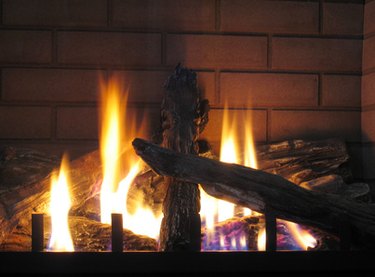
Wood is one of the most environmentally friendly burning materials. Different types of wood differ in their burning capacity, which also depends on other conditions, including moisture, seasoning and age. Wood in which the moisture content is greater than 25 percent, and rotten wood, which lacks many of the chemicals and resins that make it burn well, are the worst types of firewood. Old, dead and decaying logs, otherwise known as punky logs which are typically left untreated, are high in moisture. Their burning is directly associated with numerous health and environmental hazards and are best avoided.
Volatile Gases
Video of the Day
Burning wood releases volatile gases: compounds of oxygen, hydrogen and carbon. These volatile gases are what are commonly referred to as "smoke." The exact concentration of oxygen, hydrogen and carbon in smoke varies with the condition and the species of the old wood. Seasoned, dry wood typically generates the most heat and the least harmful smoke. However, seasoned, wet wood gives off more smoke than it does heat and gives off respirable suspended particulate matter (RSPM), suspended particulate matter (SPM) and nitrogen oxides (NOx). Respirable suspended particulate matter cause a range of respiratory illnesses, including asthma and chronic bronchitis as well as heart disease. Suspended particulate matter lead to asthma, lung disease and cancer. Nitrogen oxides lead to airway resistance, lung problems, tightness in the chest and viral infections. These pollutants combine in the atmosphere to form ozone and other dangerous pollutants.
Video of the Day
Carbon Dioxide
Wood is an organic compound, and carbon make ups approximately half its weight. Carbon dioxide, therefore, is the most abundantly produced gas when wood burns. Much of this carbon dioxide is used up by plants and converted into glucose and oxygen in photosynthesis, therefore maintaining the carbon balance. However, burning untreated and moisture-rich old wood releases more carbon dioxide than that released when dry, seasoned wood burns, which directly leads to a greenhouse effect by increasing the concentration of harmful atmospheric carbon dioxide.
Carbon Monoxide
Carbon monoxide (CO) is an odorless, colorless gas that is produced by the incomplete burning of wood. CO poisoning causes unconsciousness, cherry-red lips, dizziness, vomiting/nausea and asphyxiation. According to the New York City Fire Department, everyone is at risk of exposure to carbon monoxide inhalation from fire burning, but infants and individuals with respiratory or heart conditions and low blood cell counts are at greater risk of the dangers posed.
Popping and Sparking
Species of juniper, spruce, larch and hemlock wood naturally contain moisture pockets which trap water vapor and gases. Burning older species of wood causes dangerous sparking and popping. These woods can cause major creosote buildup, which can lead to chimney fires. Creosote fires lead to house fires, loss of property and—in extreme cases, loss of valuable lives.